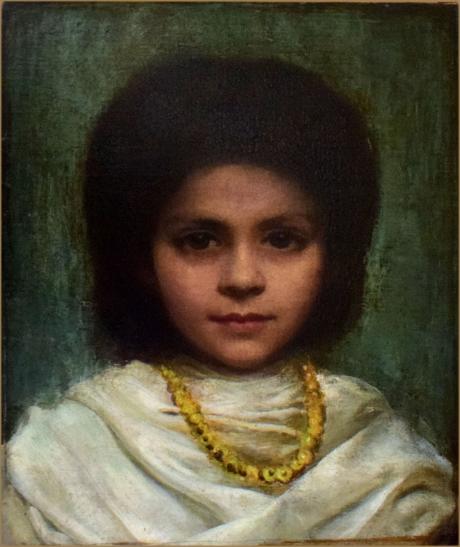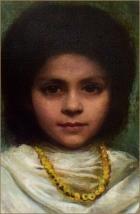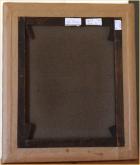Orientalism is a term used by art historians and literary and cultural studies scholars for the imitation or depiction of aspects in Middle Eastern, South Asian, and East Asian cultures. These depictions are usually done by writers, designers, and artists from the West. In particular, Orientalist painting, depicting more specifically "the Middle East",[1] was one of the many specialisms of 19th-century academic art, and the literature of Western countries took a similar interest in Oriental themes.
Since the publication of Edward Said's Orientalism in 1978, much academic discourse has begun to use the term "Orientalism" to refer to a general patronizing Western attitude towards Middle Eastern, Asian, and North African societies. In Said's analysis, the West essentializes these societies as static and undeveloped—thereby fabricating a view of Oriental culture that can be studied, depicted, and reproduced. Implicit in this fabrication, writes Said, is the idea that Western society is developed, rational, flexible, and superior.
Orientalism refers to the Orient, in reference and opposition to the Occident; the East and the West, respectively.The word Orient entered the English language as the Middle French orient. The root word oriēns, from the Latin Oriēns, has synonymous denotations: The eastern part of the world; the sky whence comes the sun; the east; the rising sun, etc.; yet the denotation changed as a term of geography. In the "Monk's Tale" (1375), Geoffrey Chaucer wrote: "That they conquered many regnes grete / In the orient, with many a fair citee." The term "orient" refers to countries east of the Mediterranean Sea and Southern Europe. In Place of Fear (1952), Aneurin Bevan used an expanded denotation of the Orient that comprehended East Asia: "the awakening of the Orient under the impact of Western ideas". Edward Said said that Orientalism "enables the political, economic, cultural and social domination of the West, not just during colonial times, but also in the present."
In art history, the term Orientalism refers to the works of the Western artists who specialized in Oriental subjects, produced from their travels in Western Asia, during the 19th century. In that time, artists and scholars were described as Orientalists, especially in France, where the dismissive use of the term "Orientalist" was made popular by the art critic Jules-Antoine Castagnary. Despite such social disdain for a style of representational art, the French Society of Orientalist Painters was founded in 1893, with Jean-Léon Gérôme as the honorary president; whereas in Britain, the term Orientalist identified "an artist".
The formation of the French Orientalist Painters Society changed the consciousness of practitioners towards the end of the 19th century, since artists could now see themselves as part of a distinct art movement. As an art movement, Orientalist painting is generally treated as one of the many branches of 19th-century academic art; however, many different styles of Orientalist art were in evidence. Art historians tend to identify two broad types of Orientalist artist: the realists who carefully painted what they observed and those who imagined Orientalist scenes without ever leaving the studio. French painters such as Eugène Delacroix (1798–1863) and Jean-Léon Gérôme (1824–1904) are widely regarded as the leading luminaries of the Orientalist movement.
In the book Orientalism (1978), the cultural critic Edward Said redefined the term Orientalism to describe a pervasive Western tradition — academic and artistic — of prejudiced outsider-interpretations of the Eastern world, which was shaped by the cultural attitudes of European imperialism in the 18th and 19th centuries. The thesis of Orientalism develops Antonio Gramsci's theory of cultural hegemony, and Michel Foucault's theorisation of discourse (the knowledge-and-power relation) to criticise the scholarly tradition of Oriental studies. Said criticised contemporary scholars who perpetuated the tradition of outsider-interpretation of Arabo-Islamic cultures, especially Bernard Lewis and Fouad Ajami.
The analyses are of Orientalism in European literature, especially French literature, and do not analyse visual art and Orientalist painting. In that vein, the art historian Linda Nochlin applied Said's methods of critical analysis to art, "with uneven results". In the academy, the book Orientalism (1978) became a foundational text of post-colonial cultural studies. Moreover, in relation to the cultural institution of citizenship, Orientalism has rendered the concept of citizenship as a problem of epistemology, because citizenship originated as a social institution of the Western world; as such, the problem of defining citizenship reconfigures the idea of Europe in time of crises.
Furthermore, Said said that Orientalism, as an "idea of representation is a theoretical one: The Orient is a stage on which the whole East is confined" in order to make the Eastern world "less fearsome to the West"; that the developing world, primarily the West, is the cause of colonialism. Moreover, in Empire: A Very Short Introduction (2000), Stephen Howe agreed with Said that Western nations and their empires were created by the exploitation of underdeveloped countries, by the extraction of wealth and labour from one country to another country.
A "Bellini type" Islamic prayer rug, seen from the top, at the feet of the Virgin Mary, in Gentile Bellini's Madonna and Child Enthroned, late 15th century Depictions of Islamic "Moors" and "Turks" (imprecisely named Muslim groups of southern Europe, North Africa and West Asia) can be found in Medieval, Renaissance, and Baroque art. In Biblical scenes in Early Netherlandish painting, secondary figures, especially Romans, were given exotic costumes that distantly reflected the clothes of the Near East. The Three Magi in Nativity scenes were an especial focus for this. In general art with Biblical settings would not be considered as Orientalist except where contemporary or historicist Middle Eastern detail or settings is a feature of works, as with some paintings by Gentile Bellini and others, and a number of 19th century works. Renaissance Venice had a phase of particular interest in depictions of the Ottoman Empire in painting and prints. Gentile Bellini, who travelled to Constantinople and painted the Sultan, and Vittore Carpaccio were the leading painters. By then the depictions were more accurate, with men typically dressed all in white. The depiction of Oriental carpets in Renaissance painting sometimes draws from Orientalist interest, but more often just reflects the prestige these expensive objects had in the period.
Jean-Étienne Liotard (1702–1789) visited Istanbul and painted numerous pastels of Turkish domestic scenes; he also continued to wear Turkish attire for much of the time when he was back in Europe. The ambitious Scottish 18th-century artist Gavin Hamilton found a solution to the problem of using modern dress, considered unheroic and inelegant, in history painting by using Middle Eastern settings with Europeans wearing local costume, as travelers were advised to do. His huge James Dawkins and Robert Wood Discovering the Ruins of Palmyra (1758, now Edinburgh) elevates tourism to the heroic, with the two travelers wearing what look very like togas. Many travelers had themselves painted in exotic Eastern dress on their return, including Lord Byron, as did many who had never left Europe, including Madame de Pompadour. The growing French interest in exotic Oriental luxury and lack of liberty in the 18th century to some extent reflected a pointed analogy with France's own absolute monarchy.Byron's poetry was highly influential in introducing Europe to the heady cocktail of Romanticism in exotic Oriental settings which was to dominate 19th century Oriental art.
French Orientalist painting was transformed by Napoleon's ultimately unsuccessful invasion of Egypt and Syria in 1798–1801, which stimulated great public interest in Egyptology, and was also recorded in subsequent years by Napoleon's court painters, especially Antoine-Jean Gros, although the Middle Eastern campaign was not one on which he accompanied the army. Two of his most successful paintings, Bonaparte Visiting the Plague Victims of Jaffa (1804) and Battle of Abukir (1806) focus on the Emperor, as he was by then, but include many Egyptian figures, as does the less effective Napoleon at the Battle of the Pyramids (1810). Anne-Louis Girodet de Roussy-Trioson's La Révolte du Caire (1810) was another large and prominent example. A well-illustrated Description de l'Égypte was published by the French Government in twenty volumes between 1809 and 1828, concentrating on antiquities.
Eugène Delacroix's first great success, The Massacre at Chios (1824) was painted before he visited Greece or the East, and followed his friend Théodore Géricault's The Raft of the Medusa in showing a recent incident in distant parts that had aroused public opinion. Greece was still fighting for independence from the Ottomans, and was effectively as exotic as the more Near Eastern parts of the empire. Delacroix followed up with Greece on the Ruins of Missolonghi (1827), commemorating a siege of the previous year, and The Death of Sardanapalus, inspired by Lord Byron, which although set in antiquity has been credited with beginning the mixture of sex, violence, lassitude and exoticism which runs through much French Orientalist painting. In 1832, Delacroix finally visited what is now Algeria, recently conquered by the French, and Morocco, as part of a diplomatic mission to the Sultan of Morocco. He was greatly struck by what he saw, comparing the North African way of life to that of the Ancient Romans, and continued to paint subjects from his trip on his return to France. Like many later Orientalist painters, he was frustrated by the difficulty of sketching women, and many of his scenes featured Jews or warriors on horses. However, he was apparently able to get into the women's' quarters or harem of a house to sketch what became Women of Algiers; few later harem scenes had this claim to authenticity.
When Ingres, the director of the French Académie de peinture, painted a highly colored vision of a Turkish bath, he made his eroticized Orient publicly acceptable by his diffuse generalizing of the female forms (who might all have been the same model). More open sensuality was seen as acceptable in the exotic Orient. This imagery persisted in art into the early 20th century, as evidenced in Henri Matisse's orientalist semi-nudes from his Nice period, and his use of Oriental costumes and patterns. Ingres' pupil Théodore Chassériau (1819–1856) had already achieved success with his nude The Toilette of Esther (1841, Louvre) and equestrian portrait of Ali-Ben-Hamet, Caliph of Constantine and Chief of the Haractas, Followed by his Escort (1846) before he first visited the East, but in later decades the steamship made travel much easier and increasing numbers of artists traveled to the Middle East and beyond, painting a wide range of Oriental scenes.
In many of these works, they portrayed the Orient as exotic, colorful and sensual, not to say stereotyped. Such works typically concentrated on Arab, Jewish, and other Semitic cultures, as those were the ones visited by artists as France became more engaged in North Africa. French artists such as Eugène Delacroix, Jean-Léon Gérôme and Jean-Auguste-Dominique Ingres painted many works depicting Islamic culture, often including lounging odalisques. They stressed both lassitude and visual spectacle. Other scenes, especially in genre painting, have been seen as either closely comparable to their equivalents set in modern-day or historical Europe, or as also reflecting an Orientalist mind-set in the Saidian sense of the term. Gérôme was the precursor, and often the master, of a number of French painters in the later part of the century whose works were often frankly salacious, frequently featuring scenes in harems, public baths and slave auctions (the last two also available with classical decor), and responsible, with others, for "the equation of Orientalism with the nude in pornographic mode";
The artist came from a Swiss Huguenot family. His father was the engraver Paul Girardet (1821-1893). He studied at the École des Beaux-arts and in the studios of Jean-Léon Gérôme, who encouraged him to visit North Africa in 1874. He had long been inspired to travel by his uncles Karl and Edouard, who had journeyed to, and painted, Egypt; and from his father Paul, who had engraved episodes of the colonial war in Algeria after Horace Vernet. In 1874, Girardet embarked for Morocco, then travelled to Tunisia and Algeria, for which he developed a particular fondness. He spent subsequent visits in Algiers and Boghari, but above all in El Kantara and Bou-Saâda, in the foothills of the Saharan Atlas, painting scenes of daily life like the present one.
In all, he made eight trips to Algeria after 1879 (some with his brothers Jules and Léon), especially to the south, around the oases of Biskra, El Kantara and Bou Saâda, where he worked with Étienne Dinet. In 1898, he visited Egypt and Palestine, producing many works depicting the lives of desert nomads.
He exhibited regularly at the Salon and with the Société des Peintres Orientalistes Français (of which he was one of the founding members), with major shows at the Exposition Universelle (1900) and the Exposition Coloniale de Marseille of 1906.
In addition to several museums in France, his works may also be seen at the Dahesh Museum of Art and the National Museum of Fine Arts of Algiers.



